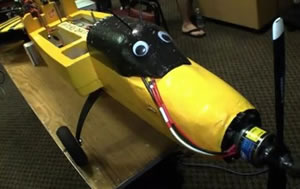

WIFI Hacking from the sky... You have to love it !
(From www.rabbit-hole.com)
When two guys interested in computer security get bored, it's usually a recipe for trouble.

(Wi-Fi Aerial Surveillance Platform). It's an autonomous Unmanned Aerial Vehicle (UAV) that we built in our garage with onboard war-driving gear, among other things.
It didn't take long before we decided Wi-Fi networks weren't enough. So we added Bluetooth, Cellular, and imaging capabilities that we can easily add and remove based on our needs. It all plugs into an onboard USB hub, so the possibilities are infinite.
Oh, and we're not Dutch. Mike (a.k.a. RedQueen) lives in Indiana. Rich (a.k.a. WhiteQueen) lives in Illinois. We're Midwest, corn-fed Americans. Not that there's anything wrong with being Dutch.
Our goals were relatively simple. We wanted it to be cheap enough that we wouldn't go broke building it. Not wanting to scratchbuild every component, it needed to use as much off-the-shelf equipment as possible. It needed to fly long enough to be able to do something interesting. One person should be able to load it in and out of a station wagon without any special equipment. Finally, and most importantly, we wanted anyone to be able to follow in our footsteps without needing to be a PhD, electrical engineer, or aeronautical engineer.
The airframe is a surplus U.S. Army target practice drone. A DIY Drones "ArduPilot" (based on the popular Arduino) controls the avionics. An onboard Via Epia Pico ITX PC with a Via C7 500 MHz CPU with 1 GB RAM, running the Backtrack 4 suite provides the "surveillance" capabilities.
It communicates with a ground station for real-time tracking, payload interaction, flight operations, and data download. An ArduStation in the base station receives the telemetry data. The base station runs on a 1 GHz Via Pico ITX PC with 1 GB of RAM. It allows us to establish a Secure Shell link via a PPP tunnel. Additionally, it can serve as a network router for connecting additional workstations to the payload system. The UAV also contains an Edge/3G connection, giving the aircraft onboard Internet connectivity. This connection allows the operator to control the payload from anywhere in the world -- including mobile devices. It also allows for processor-intensive applications, such as WPA attacks and password cracking, to be offloaded securely in real-time to a remote computing powerhouse utilizing CUDA technology, for mind-blowing performance.
Altogether, WASP weighs approximately 13 pounds, with a length of 76 inches and a wingspan of 67 inches. Its flight time is approximately 30-45 minutes, with a maximum estimated altitude of around 22,000 feet. It flies a preprogrammed set of GPS coordinates, while collecting data, and returns to base. We can also interrupt the course, and cause the UAV to "loiter" around an interesting target, allowing us more time to investigate.
http://www.rabbit-hole.org/
 Saturday, August 21, 2010 at 11:18AM
Saturday, August 21, 2010 at 11:18AM  (Wi-Fi Aerial Surveillance Platform). It's an autonomous Unmanned Aerial Vehicle (UAV) that we built in our garage with onboard war-driving gear, among other things.
(Wi-Fi Aerial Surveillance Platform). It's an autonomous Unmanned Aerial Vehicle (UAV) that we built in our garage with onboard war-driving gear, among other things.  George |
George |  Post a Comment |
Post a Comment | 














Reader Comments